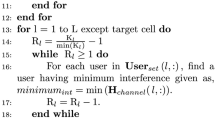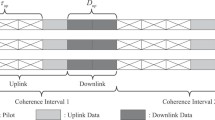Abstract
Massive multiple-input multiple-output (MIMO) has been considered as one of the most promising technologies for addressing high data rates and capacity for cellular networks in the fifth generation and beyond. In massive MIMO, the base station (BS) requires complete and accurate channel state information (CSI) for realizing the benefits of massive MIMO technology. The CSI can be obtained either through feedback from users or channel reciprocity technique. The use of non-orthogonal pilot sequences, sent by the users for determining CSI, has been the main source of pilot contamination in the uplink data communications. Various pilot contamination scenarios and their possible solutions have been extensively studied in the last few years. In this chapter, recent works in the area of mitigating the effects of pilot contamination have been presented and analyzed. Some of the higher throughput resulting algorithms and their capabilities in eliminating the effects of pilot contamination have been studied in detail.
Access this chapter
Tax calculation will be finalised at checkout
Purchases are for personal use only
Similar content being viewed by others
References
Adhikary A, Nam J, Ahn J, Caire G (2013) Joint spatial division and multiplexing-the large-scale array regime. IEEE Trans Inf Theory 59(10):6441–6463. https://doi.org/10.1109/TIT.2013.2269476
Appaiah K, Ashikhmin A, Marzetta TL (2010) Pilot contamination reduction in multi-user TDD systems. In: 2010 IEEE international conference on communications, pp 1–5. https://doi.org/10.1109/ICC.2010.5502810
Ashikhmin A, Marzetta T (2012) Pilot contamination precoding in multi-cell large scale antenna systems. In: 2012 IEEE International symposium on information theory proceedings, pp 1137–1141. https://doi.org/10.1109/ISIT.2012.6283031
Boccardi F, Heath RW, Lozano A, Marzetta TL, Popovski P (2014) Five disruptive technology directions for 5g. IEEE Commun Mag 52(2):74–80. https://doi.org/10.1109/MCOM.2014.6736746
Chávez-Santiago R, Szydełko M, Kliks A, Foukalas F, Haddad Y, Nolan KE, Kelly MY, Masonta MT, Balasingham I (2015) 5G: The convergence of wireless communications. Wirel Pers Commun 83(3):1617–1642
Chen J, Berry RA, Honig ML (2007) Performance of limited feedback schemes for downlink OFDMA with finite coherence time. In: 2007 IEEE international symposium on information theory, pp 2751–2755. https://doi.org/10.1109/ISIT.2007.4557186
Chu S, Wang X, Yang Y (2014) Adaptive scheduling in MIMO-based heterogeneous ad hoc networks. IEEE Trans Mobile Comput 13:964–978
Elijah O, Leow CY, Rahman TA, Nunoo S, Iliya SZ (2016) A comprehensive survey of pilot contamination in massive MIMO-5G system. IEEE Commun Surv Tutor 18(2):905–923. https://doi.org/10.1109/COMST.2015.2504379
Eslami M, Krzymień WA (2009) Limited-feedback multiuser MIMO-OFDM downlink with spatial multiplexing and per-chunk/per-antenna user scheduling. Springer, Netherlands, Dordrecht, pp 269–278
Eslami M, Krzymien WA (2011) Net throughput maximization of per-chunk user scheduling for MIMO-OFDM downlink. IEEE Trans Veh Technol 60:4338–4348
Fakhereddin M, Sharif M, Hassibi B (2009) Reduced feedback and random beamforming for OFDM MIMO broadcast channels. IEEE Trans Commun 57:3827–3835
Fernandes F, Ashikhmin A, Marzetta T (2012) Interference reduction on cellular networks with large antenna arrays. In: IEEE international conference on communications (ICC), pp 1–5
Fernandes F, Ashikhmin A, Marzetta TL (2013) Inter-cell interference in noncooperative tdd large scale antenna systems. IEEE J Sel Areas Commun 31(2):192–201. https://doi.org/10.1109/JSAC.2013.130208
Gopalakrishnan B, Jindal N (2011) An analysis of pilot contamination on multi-user MIMO cellular systems with many antennas. In: 2011 IEEE 12th international workshop on signal processing advances in wireless communications, pp 381–385. https://doi.org/10.1109/SPAWC.2011.5990435
Hossain E, Hasan M (2015) 5G cellular: Key enabling technologies and research challenges. IEEE Instrum Measur Mag 18(3):11–21. https://doi.org/10.1109/MIM.2015.7108393
Hou X, Harada A, Suda H (2012) Experimental study of advanced MU-MIMO scheme with antenna calibration for the evolving LTE TDD system. In: 2012 IEEE 23rd International symposium on personal, indoor and mobile radio communications (PIMRC), pp 2443–2448. https://doi.org/10.1109/PIMRC.2012.6362767
Jin S, Li M, Huang Y, Du Y, Gao X (2015) Pilot scheduling schemes for multi-cell massive multiple-input multiple-output transmission. IET Commun 9(5):689–700. https://doi.org/10.1049/iet-com.2014.0842
Jorswieck E, Sezgin A, Ottersten B, Paulraj A (2008) Feedback reduction in uplink MIMO OFDM systems by chunk optimization. EURASIP J Adv Sig Process 1–14. https://doi.org/10.1155/2008/597072
Jose J, Ashikhmin A, Marzetta TL, Vishwanath S (2011) Pilot contamination and precoding in multi-cell tdd systems. IEEE Trans Wirel Commun 10(8):2640–2651. https://doi.org/10.1109/TWC.2011.060711.101155
Kurras M (2013) Positioning of multi-node/multi-antenna transmission technologies. https://doi.org/10.13140/RG.2.1.1888.9201
Larsson EG, Edfors O, Tufvesson F, Marzetta TL (2014) Massive MIMO for next generation wireless systems. IEEE Commun Mag 52(2):186–195. https://doi.org/10.1109/MCOM.2014.6736761
Li Q, Niu H, Papathanassiou A, Wu G (2014) 5g network capacity: Key elements and technologies. Veh Technol Mag 9:71–78 (IEEE). https://doi.org/10.1109/MVT.2013.2295070
Lu L, Li GY, Swindlehurst AL, Ashikhmin A, Zhang R (2014) An overview of massive mimo: benefits and challenges. IEEE J Sel Top Sig Process 8(5):742–758. https://doi.org/10.1109/JSTSP.2014.2317671
Marzetta TL (2006) How much training is required for multiuser mimo? In: 2006 Fortieth Asilomar conference on signals, systems and computers, pp 359–363. https://doi.org/10.1109/ACSSC.2006.354768
Marzetta TL (2010) Noncooperative cellular wireless with unlimited numbers of base station antennas. IEEE Trans Wirel Commun 9(11):3590–3600. https://doi.org/10.1109/TWC.2010.092810.091092
Medard M (2000) The effect upon channel capacity in wireless communications of perfect and imperfect knowledge of the channel. IEEE Trans Inf Theory 46(3):933–946. https://doi.org/10.1109/18.841172
Min M, Kim D, Kim H, Im G (2013) Opportunistic two-stage feedback and scheduling for MIMO downlink systems. IEEE Trans Commun 61:312–324
Mueller RR, Vehkaperae M, Cottatellucci L (2013) Blind pilot decontamination. In: WSA 2013; 17th International ITG workshop on smart antennas, pp 1–6
Naeem M, Lee D (2014) A joint antenna and user selection scheme for multiuser MIMO system. Elsevier App Soft Comput 23:366–374
Nam J, Ahn J, Adhikary A, Caire G (2012) Joint spatial division and multiplexing: realizing massive MIMO gains with limited channel state information. In: 2012 46th Annual conference on information sciences and systems (CISS), pp 1–6. https://doi.org/10.1109/CISS.2012.6310934
Ngo HQ, Marzetta TL, Larsson EG (2011) Analysis of the pilot contamination effect in very large multicell multiuser MIMO systems for physical channel models. In: 2011 IEEE international conference on acoustics, speech and signal processing (ICASSP), pp 3464–3467. https://doi.org/10.1109/ICASSP.2011.5947131
Ngo HQ, Larsson EG, Marzetta TL (2013) Energy and spectral efficiency of very large multiuser mimo systems. IEEE Trans Commun 61(4):1436–1449. https://doi.org/10.1109/TCOMM.2013.020413.110848
Osseiran A, Boccardi F, Braun V, Kusume K, Marsch P, Maternia M, Queseth O, Schellmann M, Schotten H, Taoka H, Tullberg H, Uusitalo MA, Timus B, Fallgren M (2014) Scenarios for 5g mobile and wireless communications: the vision of the metis project. IEEE Commun Mag 52(5):26–35. https://doi.org/10.1109/MCOM.2014.6815890
Pattanayak P, Kumar P (2015) A computationally efficient genetic algorithm for MIMO broadcast scheduling. Elsevier Appl Comput 37:545–553
Pattanayak P, Kumar P (2016) Quantized feedback MIMO scheduling for heterogeneous broadcast networks. Springer Wireless Networks, pp 1–18
Pattanayak P, Kumar P (2017) Quantized feedback scheduling for MIMO-OFDM broadcast networks with subcarrier clustering. Elsevier Ad Hoc Netw 65:26–37
Pattanayak P, Kumar P (2018) Combined user and antenna scheduling scheme for MIMO-OFDM networks. Telecommun Syst. https://doi.org/10.1007/s11235-018-0462-0
Pattanayak P, Kumar P (2019) An efficient scheduling scheme for MIMO-OFDM broadcast networks. AEU Int J Electron Commun 101:15–26. 10.1016/j.aeue.2019.01.017, http://www.sciencedirect.com/science/article/pii/S1434841118300359
Pattanayak P, Kumar P (2020) Computationally efficient scheduling schemes for multiple antenna systems using evolutionary algorithms and swarm optimization. In: Gandomi AH, Emrouznejad A, Jamshidi MM, Deb K, Rahimi I (eds) Evolutionary computation in scheduling. Wiley, chap 5, pp 105–135
Pattanayak P, Kumar P (2016) SINR based limited feedback scheduling for MIMO-OFDM heterogeneous broadcast networks. In: Proceedings of the IEEE twenty second national conference on communication (NCC), Mar 2016
Pattanayak P, Roy KM, Kumar P (2015) Analysis of a new MIMO broadcast channel limited feedback scheduling algorithm with user grouping. Springer Wirel Pers Commun 80:1079–1094
Pattanayak P, Trivedi VK, Chakraborty S, Kumar P (2017) BER performance of multi user scheduling for MIMO-STBC and MIMO-OFDM broadcast network with imperfect CSI. In: 2017 4th International conference on signal processing and integrated networks (SPIN), pp 66–70. https://doi.org/10.1109/SPIN.2017.8049917
Peng Xu, Wang J, Wang J (2013) Effect of pilot contamination on channel estimation in massive MIMO systems. In: 2013 International conference on wireless communications and signal processing, pp 1–6. https://doi.org/10.1109/WCSP.2013.6677112
Prasad N, Zhang H, Zhu H, Rangarajan S (2013) Multi-user MIMO scheduling in the fourth generation cellular uplink. IEEE Trans Wirel Commun 12(9):4272–4285. https://doi.org/10.1109/TWC.2013.072513.120734
Rusek F, Persson D, Lau BK, Larsson EG, Marzetta TL, Edfors O, Tufvesson F (2013) Scaling up mimo: opportunities and challenges with very large arrays. IEEE Sig Process Mag 30(1):40–60. https://doi.org/10.1109/MSP.2011.2178495
Stuber GL, Barry JR, McLaughlin SW, Li Y, Ingram MA, Pratt TG (2004) Broadband MIMO-OFDM wireless communications. Proc IEEE 92(2):271–294. https://doi.org/10.1109/JPROC.2003.821912
Svedman P, Wilson S, Cimini L, Ottersten B (2007) Opportunistic beamforming and scheduling for OFDMA systems. IEEE Trans Commun 55:941–952
Wang F, Bialkowski ME, Bialkowski KS (2013) Successive user scheduling schemes for a multiuser MIMO system employing generalized channel inversion. Springer Wirel Pers Commun 68:401–416
Wang H, Huang Y, Jin S, Yu F, Yang L (2013) Performance analysis on precoding and pilot scheduling in very large MIMO multi-cell systems. In: 2013 IEEE wireless communications and networking conference (WCNC), pp 2722–2726. https://doi.org/10.1109/WCNC.2013.6554992
Xu W, Cao Y, Zhao C (2013) Capacity analysis of MIMO group-broadcast channels with time-division scheduling. Springer Wirel Pers Commun 68:1331–1350
Yin H, Gesbert D, Filippou M, Liu Y (2013) A coordinated approach to channel estimation in large-scale multiple-antenna systems. IEEE J Sel Areas Commun 31(2):264–273. https://doi.org/10.1109/JSAC.2013.130214
Yue S, Liu J, Zhai C, Wang Q (2015) User pilot scheduling in massive MIMO systems. In: 2015 International conference on wireless communications signal processing (WCSP), pp 1–5. https://doi.org/10.1109/WCSP.2015.7341058
Zhang C, Zeng G (2014) Pilot contamination reduction scheme in massive MIMO multi-cell TDD systems. J Comput Syst Sci 10(15):6721–6729
Zhou Z, Wang D (2016) Pilot scheduling based on water-filling algorithm in massive MIMO. In: 2016 6th International conference on electronics information and emergency communication (ICEIEC), pp 89–92. https://doi.org/10.1109/ICEIEC.2016.7589694
Zhu X, Wang Z, Dai L, Qian C (2015) Smart pilot assignment for massive MIMO. IEEE Commun Lett 19(9):1644–1647. https://doi.org/10.1109/LCOMM.2015.2409176
Author information
Authors and Affiliations
Corresponding author
Editor information
Editors and Affiliations
Rights and permissions
Copyright information
© 2021 Springer Nature Singapore Pte Ltd.
About this chapter
Cite this chapter
Dey, A., Pattanayak, P., Singh Gurjar, D. (2021). Pilot Contamination in Massive MIMO Communications. In: Mandloi, M., Gurjar, D., Pattanayak, P., Nguyen, H. (eds) 5G and Beyond Wireless Systems. Springer Series in Wireless Technology. Springer, Singapore. https://doi.org/10.1007/978-981-15-6390-4_2
Download citation
DOI: https://doi.org/10.1007/978-981-15-6390-4_2
Published:
Publisher Name: Springer, Singapore
Print ISBN: 978-981-15-6389-8
Online ISBN: 978-981-15-6390-4
eBook Packages: EngineeringEngineering (R0)




